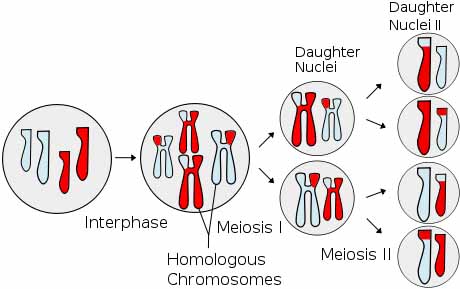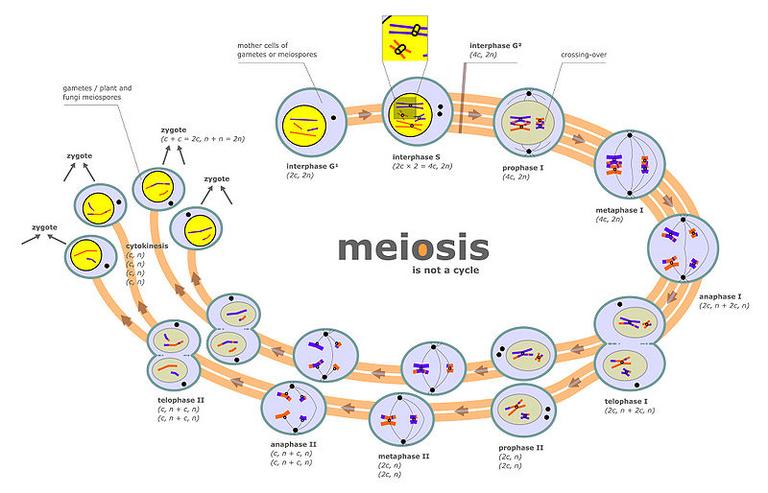 | ||||
Meiotic Cell Division & Sexual Reproduction - P2
Meiosis I & II
As is the case in mitosis, in meiosis the cell duplicates its chromosome number prior to beginning cellular division (a process called
replication). Then nuclear division, the sorting out of the genetic material, unfolds over the course of 2 cellular divisions (meiosis I and meiosis II), resulting in 4 gametes.
Meiosis I
During meiosis I, homologuous pairs of chromosomes
buddy up at the cell’s equator and then each homologue moves to opposite ends of the cell.
Human Fertilization
Independent assortment and crossing over of meiosis are only part of the reason sexual reproduction allows for so much genetic variation between individuals. Human males can produce millions of sperm and human females millions of eggs (although only a fraction mature and are ovulated). Put these one-of-a-kind gametes together and the result is a genetically unique individual. Fertilization is the final genetic shuffle.
Visual & Animated Resources to Help Students Understand Meiosis
- Meiosis Interactive Animation from Cells Alive
- How Meiosis Works, animation & quiz from McGraw-Hill
- Unique Features of Meiosis animation and quiz from McGraw-Hill
- Comparison of Meiosis & Mitosis, animation & quiz from McGraw-Hill
- Genetics: Tour of the Basics, Genetic Science Learning Center, University of Utah
SPO VIRTUAL CLASSROOMS
Page last updated: 10/2015
You have free access to a large collection of materials used in a college-level introductory Cell Biology Course. The Virtual Cell Biology Classroom provides a wide range of free educational resources including Power Point Lectures, Study Guides, Review Questions and Practice Test Questions.
The SPO website is best viewed in Microsoft Explorer, Google Chrome or Apple Safari.
You have FREE access to a large collection of materials used in a college-level introductory biology course. The Virtual Biology Classroom provides a wide range of free educational resources including PowerPoint Lectures, Study Guides, Review Questions & Practice Test Questions.
PAGE 2 < Back to Page 1
End of Article
 | ||||||
SPO is a FREE science education website. Donations are key in helping us provide this resource with fewer ads.
Please help!
(This donation link uses PayPal on a secure connection.)
 | ||||
What started with one cell, now consists of two cells that each have a 23 duplicated chromosomes.
There are two events that occur during meiosis I that contribute to the astounding genetic variation the sexual reproduction produces:
- Independent assortment
- Crossing over
Independent Assortment
In human cells there are 23 pairs of chromosomes. This means that during meiosis I there are many different possible arrangements of these pairs.
How homologous chromosomes line up during meiosis I determines, in the end, the combination of chromosomes that end up ends up in each gamete. This is one of the reasons why sexual reproduction produces such astounding genetic variation.
Meiosis II
Meiosis II unfolds much like mitosis does, but without the chromosomes replicating before nuclear division. Each duplicated chromosome left over from meiosis I lines up at the two cells' equators and these sister chromatids (as the duplicates are called) separate and move to opposite poles. Meiosis II ultimately results in 4 cells that, in humans, each have 23 (1n) chromosomes.
Crossing-Over
When homologous chromosomes are lined up next to each other during meiosis I they also can swap pieces. This is called crossing over and results in more ‘shuffling of the genetic deck.’
Meiosis I results in two cells that now have half the number of chromosomes, but those chromosomes are still duplicated. The role of meiosis II is to separate the duplicated chromosomes, resulting in four sex cells (gametes) with half the number of chromosomes (unduplicated) as the parent cell.
WHICH GENETIC TRAITS DO YOU HAVE?






